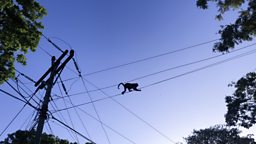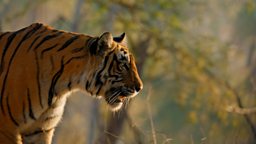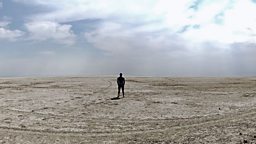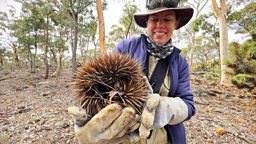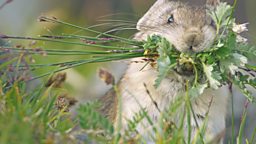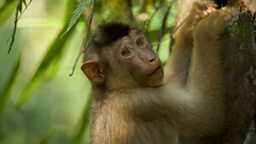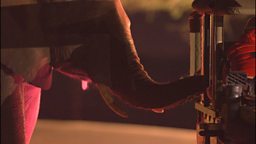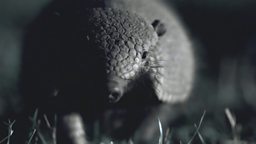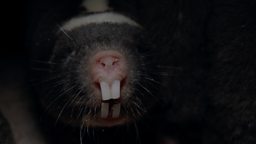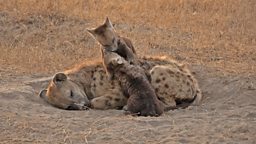Revealing the denizens of the forest
By Mammals Producer, Justine Allan

Forest mammals live in a multidimensional space which they negotiate in myriad, ingenious ways. Many of them operate as much in the vertical dimension as in the horizontal, yet only bats have the power of flight. The “flying squirrels” we filmed in Japan actually glide through the forest, sacrificing height for distance but saving the vital energy that real flying or climbing would require. Add the vertical dimension of a forest and you open up a multitude more niches for animals to fill: there is a greater diversity of mammals in forests than in any other biome. But they’re not all friends, of course: the tangled web of alliances, competition and predation presents a formidable challenge to every forest denizen, from tiny tenrecs to tigers, to enthusiastic but less well adapted film crews.
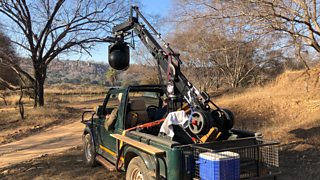
This film brings you a small selection of the forest mammals that have captivated us and shared with us their struggles, their failures and triumphs. From all the hours we’ve spent with them, I’m very pleased to be able to bring you some behaviours that have never before been filmed: the military-style tactics of chimpanzees hunting the fast and flighty red-capped mangabey aswell as foraging for underground honey; the North American bobcat dragging salmon from the forest creeks of the Pacific North-west; thousands of migrant fruit bats flying across a Zambian cityscape…
Adaptable, ingenious, awesome and endearing as all these mammals are, we needed to pick a lead character with sufficient punch to open the show. Only one ticked all the boxes: an animal so powerful, so striking and formidable that I can’t help thinking it almost shouldn’t be real: the Bengal tiger. From my first encounters with these extraordinary, intelligent predators when I came to work in the Indian wilderness of Madhya Pradesh at the age of 24, I have been absolutely captivated by them.
Later I came back to film them, following them through the bush with a jib-operated Gyro-Stabilized System (GSS) mounted on a vehicle. It's the perfect system to follow a tiger in cluttered uneven terrain. The 5-axis gimbal helps smooth out a tracking shot (on the move) and the effect created through trees is called 'parallax' where elements in the shot move at different speeds, giving a 3D-like experience. It brings a strong sense of depth to the forest on film. The jib can be a lifesaver allowing us to make micro-adjustments to the camera's view through a wall of trees. When filming tigers, moving an inch in silence can make all the difference. When your camera is fixed to the car, and you need a different angle, the only other option would be turning an engine on and moving the vehicle - in the jungle, we often don't have that luxury.
As a producer-director on this shoot, I couldn’t give much time to “jib-swinging,” but I did have the very special opportunity to pass on the baton to another enthusiastic 24 year-old: Nithin Krishna, a passionate and talented camera assistant got the job of handling the jib for our experienced cinematographer Gavin Thurston. Rounding out the team was Salim Ali, one of the most talented tiger-trackers in the business. Salim learnt the craft with his father as a small boy and his passionate dedication, 30 years later, is still thoroughly infectious and inspiring.

Riddhi, a young tigress controlling a prime territory in Ranthambhore National Park, got the starring role. She had first come into my life as a tiny cub whilst on a previous shoot following her mother, Arrowhead, and to see her now transformed into a sleek, confident 3 year-old just striking out on her first summer of independence was deeply moving. In the harsh life of tigers, getting this far is a significant triumph. Four of Arrowhead’s six other cubs had died in infancy, rumoured to be killed by crocodiles. If they were (and her hatred of crocodiles is plain to see), it makes the story of Riddhi going into the forest lakes after her own prey all the more remarkable.

Coming back to India after years of absence brought back a flood of old feelings. Nothing evoked all those emotions more than moving out into the jungle in the pre-dawn twilight. The forest lay cool and quiet but under the drowsy stillness there was buzzing anticipation. Salim had had a hunch about where we would find our elusive megacat and, though we scarcely dared hope, we knew better than to question his instinct. Golden light crept in through the trees. A sudden alarm call from a peacock nearby and our pulses picked up. The curtain of night was raised for the act… and Riddhi came strolling into view through the yellow grass and the beautiful, sun-scorched trees of Ranthambhore. The hunch had paid off. Everything had come together and the camera started turning. She walked on and we followed. Riddhi’s world opened up to us that morning, and it is with that scene that we open our film.
Summers in Ranthambhore are harsh. Leaves wither away, leaving only naked stems for cover. We documented how Riddhi has adapted her behavior, hunting the samba deer that have moved out of the forest and into the lakes, to feed on swamp weed. It's not the straightforward stalk and spring attack that we are used to seeing from tigers: hunting through the water and weed is slow and exhausting. Riddhi must first flush the deer from the lake, then take them down on the ground of her choosing: one animal doing the work of a wolf-pack. It’s a technique her great-grandmother perfected in the past, but it hasn’t been seen in Ranthambhore for many years.

Just as the wild mammals we filmed are an integral thread in the fabric of the forest, so too are we
In 20 years the tiger population has doubled in India. A large part of this success comes from involving local people in the well-being of the ecosystems that support them. Just as the wild mammals we filmed are an integral thread in the fabric of the forest, so too are we: the less we connect with our environment, tugging away on the human thread, the more we weaken the whole. Through this film, I hope to be able to help rebuild the connection, bringing the public, through the scientists, guides and crew-members in the field, back to the wild world we have put so far behind us. Staying connected makes the difference.


